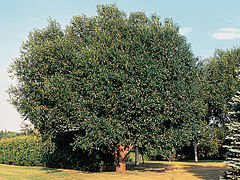Bay Willow
| Habit | tree
| |
|---|---|---|
| Height: | ⇕ | 50 ft"ft" can not be assigned to a declared number type with value 50. |
| Width: | ⇔ | 30 ft"ft" can not be assigned to a declared number type with value 30. |
| Lifespan: | ⌛ | perennial |
| Bloom: | ❀ | early spring, mid spring, late spring |
| Exposure: | ☼ | sun |
|---|---|---|
| Water: | ◍ | wet, moist |
| Features: | ✓ | flowers |
| USDA Zones: | 5 to 10 | |
| Flower features: | ❀ | orange, yellow |
|
Salix > |
L. > |
Salix pentandra (Bay Willow) is a species of willow native to northern Europe and northern Asia.[1]
It is a large shrub or small tree growing to 14 m tall (rarely to 17 m), usually growing in wet, boggy ground. The leaves are glossy dark green, 5-12 cm long and 2-5 cm broad, with a finely serrated margin. The dioecious flowers are catkins, produced in late spring after the leaves; the male catkins are yellow, 2-5 cm long, the female catkins greenish, 1.5-3 cm long; they are pollinated by bees. The fruit is a small capsule containing numerous minute seeds embedded in white down which aids wind dispersal.[1][2]
The scientific name refers to the male flowers having five stamens. The English name derives from the resemblance of the leaves to those of the Bay Laurel; other common names include Bay-leaved Willow and Laurel Willow. Its glossy leaves make it more decorative than many other willows, and it is often planted as an ornamental tree.[1]
It has become locally naturalised in northern North America, and is widely known as Laurel Leaf Willow there.
Read about Bay Willow in the Standard Cyclopedia of Horticulture
|
|---|
|
Salix pentandra. (S. laurifolia, Hort. S.Humboldtiana, Hort. not Willd.). Bay-leaf or Laurel-leaf Willow. Shrub or small tree, 8-20 ft. high: branches chestnut-color: lvs. large, elliptic to broadly oblanceolate, acuminate, shining and dark green above, paler beneath: aments appearing after many of the lvs. are fully developed, not conspicuous. Eu. and Asia.
|
Cultivation
Propagation
Pests and diseases
Varieties
Gallery
References
- Standard Cyclopedia of Horticulture, by L. H. Bailey, MacMillan Co., 1963
External links
- w:Bay Willow. Some of the material on this page may be from Wikipedia, under the Creative Commons license.
- Bay Willow QR Code (Size 50, 100, 200, 500)


